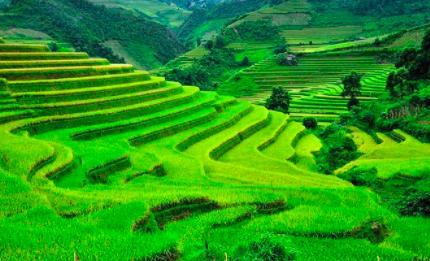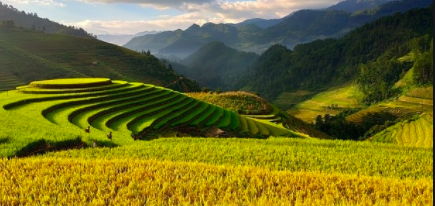Terrace farming is a method of farming that has been practised in northern India for quite some time. Terrace farming refers to the act of constructing steps or terraces to conduct farming activities on mountain slopes. Each level is made up of different crops being grown. The benefit is that the rains do not completely wash away the nutrients, but are forced down to the lowest levels. These precautions often stop a free-flowing water avalanche that could kill all crops. Aqueducts are created in this method to bring water to each level.
States, where Terrace farming takes place in India, are Punjab, Meghalaya, Haryana, Uttar Pradesh Plains, Himachal Pradesh and Uttaranchal.

Terrace farming is mainly of 2 types, Bench terrace farming and Ridge terrace farming. Bench terracing consists of converting the comparatively steep land into a sequence of steps that run across the slope, or almost level steps. On slopes, ridge terraces eliminate or hold water. There are two types of Ridge style terrace farming, narrow and broad-based.
Terrace farming allows the land to be fertile, but involves a lot of complex design and engineering and is labour intensive. But it is worth the trouble to leave uncultivated hills and mountains on the slopes.
Paddy, cereals, berries, vegetables, flowers, medicinal plants, aromatic plants, colouring plants, wheat, maize, rice, pulses, oilseeds, millets, buckwheat, saffron, black cumin, grain amaranth, spices, etc. are some crops grown using terrace farming. Apples, subtropical and temperate fruits, including nuts and dry fruits, are the main fruit crops.
If I had to define terrace farming in a few sentences, I’d say that it is the cultivation by planting on graded terraces built into the slope, a method of growing crops on the sides of hills or mountains. The system has been used efficiently, albeit labour-intensive, to increase the arable land area in complex terrains and to minimise soil erosion and water loss.
The terrace is a low flat ridge of earth constructed across the slope in most structures, with a runoff water channel just above the ridge. Terraces are typically constructed on a slight level such that the water trapped in the channel flows steadily towards the outlet of the terrace. Level terraces can be used in areas where soils are able to readily take in water and rainfall is relatively poor.
THE ADVANTAGES OF TERRACE FARMING
Now that we know what terrace farming is, you must be wondering why some parts of the world religiously follow this method. Here are some major advantages and benefits of the method that you should go through!
- Water conservation and runoff reduction are boosted by terrace farming: Terraces function as many micro-watersheds around the entire slopes. It also directly remodels the micro-topography of the slopes of the hills. By modifying hydrological pathways, these factors improve the efficiency of rainwater harvesting. Terrace farming activity also improves soil roughness and produces voids so that water droplets penetrate. Thus, water holding capacity and soil moisture are increased.
- Soil protection and soil erosion control: By reducing the water velocity and total volume of debris flow, terracing weakens rainfall-runoff results. This leads to a rise in surface cover and biomass. Terraces have embankments or ridges that enhance the efficacy of soil conservation.
- Improve land productivity and soil fertility: Terrace farming increases soil fertility and land productivity because of the reduction in soil erosion and high-water holding capacity.
- Ensuring food protection and crop yield: The mountain’s issues are water shortage and soil erosion. Via water and soil conservation, terrace farming ensures food protection and increases crop yield. It thus decreases soil erosion. In terrace farming, high yield results from the interaction between water and fertiliser.
- Enhances biodiversity and helps in ecosystem restoration and enhances biodiversity: The practice of Terrace farming in mountains or another region where standard cultivation is not possible plays an additional measure that benefits ecosystem restoration and enhancing biodiversity.
- Enriches recreational opportunities by developing aesthetic landscapes: many of the world’s terrace activities are known as cultural landscape” (UNESCO, 2008). Cultural landscapes, described by the World Heritage Committee as’ distinctive geographical areas or unique properties reflecting the combined work of nature and man’.
Terrace farming is the method of farming that has made farming in the hilly regions of the world feasible. Without terrace farming, most parts of the continent of Asia would remain barren and unproductive. Therefore, other parts of the world such as America, Africa, parts of Asia that don’t use it, should explore this method. Terrace farming is able to turn the moist idle land into productive farms leading to high food security in the world. It also helps in retaining the soil nutrients in the farms.
DISADVANTAGES OF TERRACE FARMING
In spite of being a popular method in some regions, the method of terrace farming has some disadvantages as well. Here are some that you can go through and decide whether Terrace Farming is the perfect option for you!
- One big downside to terracing is the saturation of the soil by rainwater. This occurs when too much water, which is absorbed into the soil, is preserved by terracing. The issue with soil saturation is that during times of heavy rainfall, it can lead to water overflow. This can end up causing more toxic runoff than in underestimated regions. In addition, if not properly maintained, terraces can lead to greater soil erosion than in non-terraced areas, often downhill from the terraces.
- Terracing requires immense labour inputs to build and maintain, and the results can be disastrous when not properly managed. Unmaintained terraces, particularly in sandy soils or on extremely steep terrain, can lead to mudslides, the formation of deep gulleys and increased soil erosion. Terracing has also been shown in some areas to decrease soil quality through the leaching of essential nutrients from the soil.
Terraces may also result in mudslides. It’s also costly since it is labour intensive. However, if there’s access to inexpensive labour, it can be cheap.

GETTING STARTED WITH TERRACE FARMING- 7 STEPS TO START YOUR OWN TERRACE FARM
In today’s world, where the concrete jungle is expanding, the most space that we get to plant and grow is in our balconies and terrace. Here are some steps and tips that you can keep in mind, that will help you start your own terrace garden right at your home!
- Preparing the roof: Start with water-proofing the roof and making it water-resistant and leak-free to avoid any damage to the house. Water-proofing is a straightforward method and there are numerous water-proofing items on the market. Get the one that fulfils your demands.
- Starting gardening: Start with simple steps and then let your definition grow larger and larger. Planters or pots are suitable for the garden terrace. Get a pot from the market or search your house to collect and recycle any containers. Cover the drainage hole with stones at the bottom so that the water has room to flow, but no soil is discharged. Mix equal amounts of dirt, manure, sand and vermin-compost and fill the pot. Wet the soil, plant the seeds or saplings, and watch them grow.
- Choosing the plants: Start with something that is familiar to you. Then start with those that grow quickly and do not require much effort, such as coriander, fenugreek, gramme, chilli, capsicum, spinach, etc, if you want to grow vegetables. You can grow everything once you have gained confidence, including the fruits and vegetables of your choice. It is possible to grow almost all the vegetables on the terrace. If you think that the sun is too bright on your terrace, cover the terrace with bamboo.
- Costing: If you start it from scratch and it includes containers, seeds, soils, etc a terrace garden will cost you about 20,000 INR. This is an investment. However, if you expand your garden in steps and use recycled containers as much as possible, you can decrease the cost.
- Once you have got your garden started, you can bring in the variety by trying different types of pots, plant holders, different types of plants and other decorations. With constant care and regular management, you can make the garden last and look better. Not only will adding the garden add to the aesthetic and beauty of your home, but also help you stay closer to nature!
Summing Up
Terrace farming is a type of farming that has helped farmers tackle the many problems they have faced with farming for many years now. Despite the few disadvantages of terrace farming, the advantages are many and it is a very useful method for farmers all around the world. Even people living in urban areas can start their own terrace gardens in the spaces of their homes. This blog highlights all the perks and cons of this method and will give you the basic knowledge one would need about terrace farming. If you feel that this is something that is needed and will help your farm grow, expand and get better, the time to start is now!

